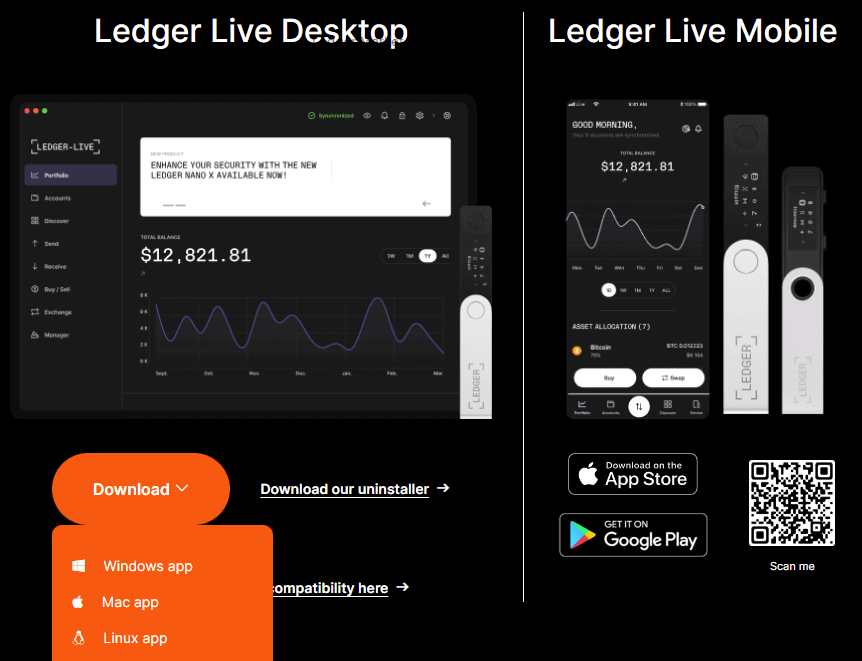What Ledger Live Desktop is
Ledger Live Desktop is the companion application for Ledger hardware wallets that brings private key security and an approachable software interface together. Running on Windows, macOS and Linux, it’s where you check balances, send and receive dozens of cryptocurrencies and tokens, install apps on your device, and interact with emerging features such as staking and NFT viewing. The distinguishing idea is separation of responsibilities: your private keys stay on the hardware device while Ledger Live provides the visual controls and network connectivity.
Core features explained
Device management
Pair a Ledger hardware wallet (Ledger Nano S Plus or Ledger Nano X) and manage firmware updates, app installations, and device settings. Ledger Live validates firmware packages and avoids exposing private keys to the desktop environment.
Multi-asset support
Ledger Live supports Bitcoin, Ethereum and thousands of ERC tokens plus many other chains — all in one interface. Each asset has its own account view that shows transaction history and current balance in native and fiat units.
Portfolio & history
Portfolio tracking aggregates holdings across accounts and devices. You can review historical performance and export transaction history for tax reporting or personal records.
Stake & earn
For supported blockchains, Ledger Live lets you delegate or stake tokens directly from the desktop app while keeping private keys offline. Staking flows are presented step-by-step to reduce mistakes.
Security model — what actually stays safe
Ledger Live is a management layer: the critical secret material — your seed phrase and private keys — never leave the hardware wallet. When you sign transactions the desktop app constructs the unsigned transaction, sends it to the device which displays a summary, and the device returns a signature only after local user confirmation. This model reduces the attack surface compared with storing keys in software wallets.
Setup & first-run tips
- Always download Ledger Live from the official Ledger website or a verified source. Verify checksums if provided.
- Create a new Ledger device seed only on the device; never type your recovery phrase into a computer or phone.
- Write your recovery phrase on paper (or on a dedicated steel backup) and store it in a safe place. Consider a split-storage approach for redundancy.
- Register a device name in Ledger Live to keep track of multiple wallets and avoid accidental account mixing.
Daily usage — safe patterns
When sending crypto, double-check recipient addresses and amounts on the hardware screen, not only on your desktop. For high-value transfers, consider sending a small test amount first. Enable automatic app updates but review changelogs for major releases; Ledger publishes release notes that are useful for understanding new permissions or feature changes.
Interacting with dApps and NFTs
Ledger Live includes integrations for Web3 workflows via Ledger Live Bridge or direct app flows. When connecting to third-party decentralized applications, verify the domain and the contract actions you’re signing. For NFTs, Ledger Live provides a viewer for supported asset standards — useful for cataloging ownership without exposing keys.
Limitations and pragmatic trade-offs
No solution is perfect. Ledger Live focuses on security and broad compatibility; you may find some niche tokens or layer-2 assets are unsupported immediately and require additional tooling. Also, firmware and app updates change device behavior — keeping both device and Ledger Live up to date is good practice, but schedule updates when you can confirm release notes and backups are in order.
Troubleshooting basics
- If the device isn’t recognized, try another cable or USB port and confirm the device is unlocked and on the home screen.
- Use the built-in repair or clean install flows if Ledger Live reports inconsistent data — exports and backups of transaction history can be performed before any destructive step.
- Contact official Ledger support for unresolved issues and avoid third-party repair services for security-sensitive tasks.
Practical tips & best practices
- Keep a small hot wallet for frequent low-value transactions and use Ledger Live + hardware wallet for bulk storage.
- Enable passphrases only after you understand how they change account derivation and backup requirements.
- Keep a clean offline copy of your recovery strategy documented (what goes where, who is informed in emergencies).
Ledger Live Desktop is a mature, actively developed piece of the Ledger ecosystem. Its central promise is to combine offline key security with an intuitive desktop experience so you can manage modern crypto tasks — sending, staking, tracking, and interacting — with confidence. Use it as the secure gateway to your hardware wallet and always treat the recovery phrase as the single source of truth for account recovery.
